Nonprofits face distinct challenges when it comes to managing relationships and driving engagement. Unlike for-profit businesses, nonprofits must balance limited budgets with the need to maintain strong donor relationships, manage volunteers, run programming, and track impact, often across dispersed teams. These unique demands require tools that go beyond traditional customer management.
That’s where nonprofit-tailored CRM (Customer Relationship Management) systems come into play. Designed to centralize data, streamline outreach, and automate administrative tasks, CRMs help nonprofit organizations better retain donors, personalize communications, and ultimately amplify their mission. According to a 2024 Nonprofit Digital Investments Report from NTEN, 14% of nonprofits spend their technology budget on software and licenses; the same report revealed that 40% of nonprofits include technology investments in their organization’s strategic plan.
In this article, I’ll break down the best CRMs specifically suited for nonprofits. You’ll find a side-by-side comparison table, a deep dive into key features (like donor management, grant tracking, and integrations), and a step-by-step guide for evaluating and implementing the right CRM for your organization.
Notably, HubSpot is one of the platforms trusted by real nonprofit organizations to drive engagement and scale their impact — and I’ll show you how.
Table of Contents
- What is a CRM for nonprofits?
- CRM Comparison Table
- Best CRM Software for Nonprofit Businesses
- Benefits of CRM Software for Nonprofits
- 5 Important Features for a Nonprofit CRM
- How to Choose a CRM for Nonprofits (Step-by-Step)
- Frequently Asked Questions
- Meet HubSpot, the Top CRM Choice for Nonprofit Companies
What is a CRM for nonprofits?
A CRM for nonprofits is software that helps organizations manage and nurture relationships with donors, volunteers, members, and other key stakeholders. It centralizes contact information, tracks engagement history, and supports fundraising, outreach, and reporting efforts—all tailored to the mission-driven goals of nonprofit work.
Best CRMs for Nonprofit Organizations at a Glance
|
CRM |
Best For |
Pricing |
Free Trial |
|
|
HubSpot |
Nonprofits seeking an all-in-one platform with a strong free tier |
Donor management Email marketing Donation tracking Volunteer coordination Automated workflows Reporting dashboard Integration with payment processors |
Free Tools: $0/month Starter: $9/month Professional: $720/month Enterprise: $2,000/month |
Yes, 14 days |
|
Salesforce Nonprofit Cloud |
Large nonprofits needing enterprise-level customization |
Comprehensive donor lifecycle management Grant tracking Program management AI-powered insights Extensive third-party integrations |
10 free licenses through Power of Us program; Additional licenses from $60/user/month (Nonprofit Cloud Enterprise tier) |
Yes, 30 days |
|
Bloomerang |
Small to mid-sized nonprofits focused on donor retention |
Donor retention analytics Giving history tracking Automated receipting Engagement timeline Wealth screening integration |
Qgiv by Bloomerang: $40/month Bloomerang CRM: $125/month Bloomerang Volunteer: $119/month |
No, demo scheduling required |
|
Keela |
Small nonprofits wanting AI-powered insights and automated communications |
Smart Ask AI for donation predictions Automated donor journeys Integrated email marketing Impact reporting Donor segmentation |
1000 contacts: $134/month 2,500 to 5,000 contacts: $274/month 5,001 to 7,500 contacts: $329 7,501 to 10,000 contacts: $379/month |
No, demo scheduling required |
|
Little Green Light |
Budget-conscious small nonprofits |
Constituent management Customizable forms Volunteer tracking Email integration Basic reporting |
2,500 contacts: $45/month 5,000 contacts: $60/month 10,000 contacts: $75/month 20,000 contacts: $90/month |
Yes, demo registration required |
Best CRM Software for Nonprofit Businesses
With so many CRM platforms on the market, it can be challenging for nonprofits to find a solution that fits their mission and budget. The best CRM software for nonprofit businesses offers tools for donor management, volunteer coordination, event tracking, and campaign reporting — all while being user-friendly and cost-effective.
Below, I’ve rounded up top CRM options tailored to the unique needs of nonprofits to help you make an informed choice. Take a look:
1. HubSpot
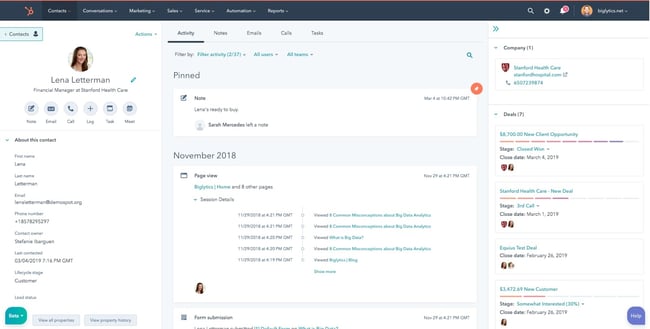
Best for: Growing nonprofits seeking an all-in-one platform to unify donor management, marketing, and fundraising without breaking the budget. Using HubSpot’s onboarding infrastructure, Swipe Out Hunger scaled from 150 to 450 campus partners in 6 months.
Key HubSpot Features
- Unified contact database: HubSpot’s CRM tracks every donor interaction in one centralized location, from first website visit tracked by HubSpot’s analytics to major gifts recorded in HubSpot’s deal pipelines, eliminating the data silos that often plague nonprofit organizations.
- Automated email workflows: HubSpot’s workflow builder lets nonprofits set up donor welcome series, lapsed donor re-engagement campaigns, and event follow-ups that trigger automatically based on specific actions within HubSpot, saving hours of manual outreach time.
- Native payment integration: HubSpot connects directly with Stripe or PayPal to process donations within the HubSpot ecosystem, automatically updating donor records in HubSpot’s CRM and triggering thank-you emails through HubSpot's email tools without manual data entry.
HubSpot Pricing (Operations Hub)
- Free Tools: $0/month
- Starter: $9/month
- Professional: $720/month
- Enterprise: $2,000/month
2. Salesforce Nonprofit Cloud
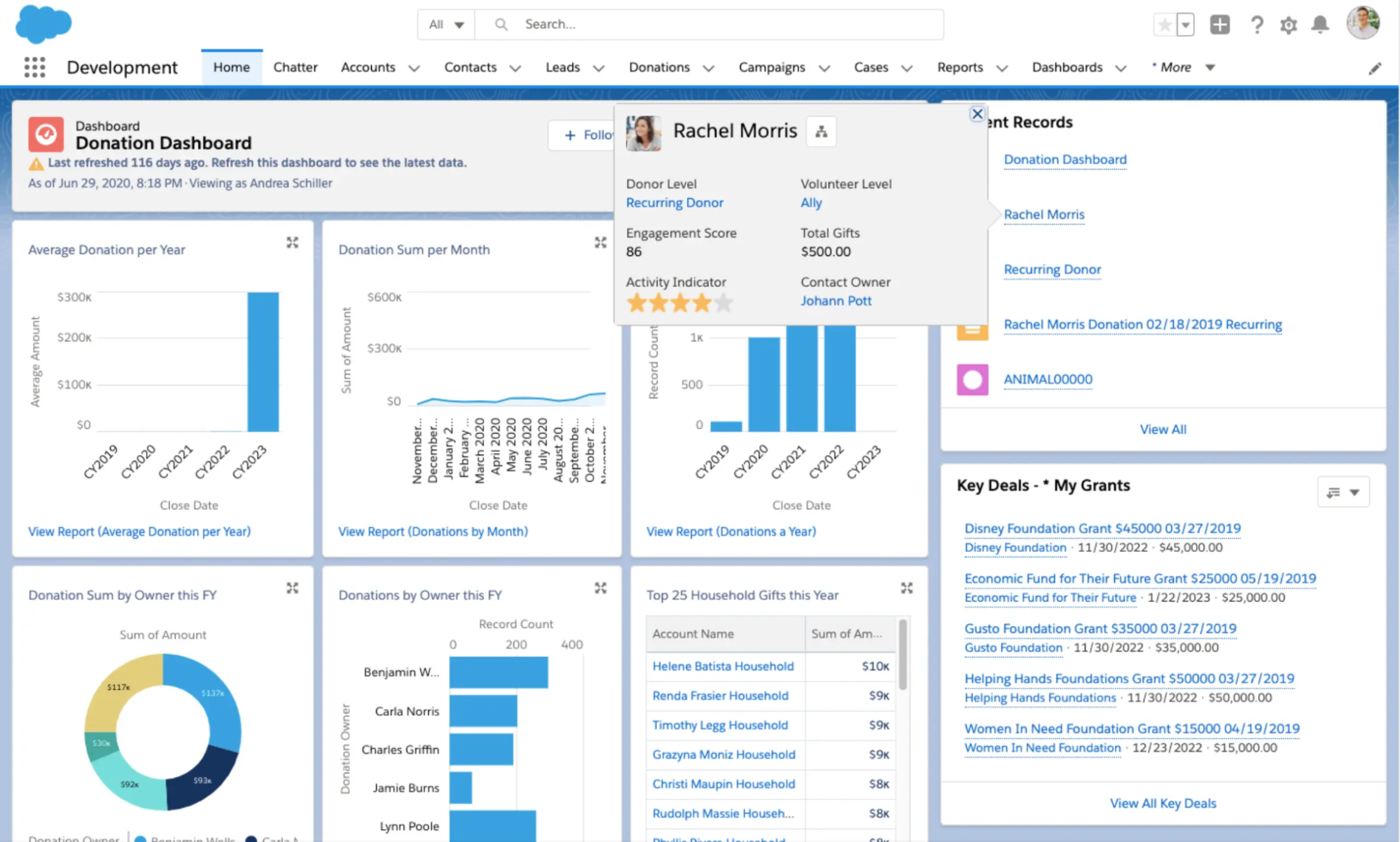
Best for: Large nonprofits and foundations managing complex programs, multiple funding sources, and enterprise-level reporting requirements.
Key Salesforce Features
- Grant management module: Track multi-year grants with automated milestone reminders and compliance reporting.
- Program impact tracking: Connect beneficiaries to programs and outcomes in real-time.
- AppExchange integrations: Access nonprofit-specific apps for peer-to-peer fundraising or form submission platforms for complex application forms, all syncing seamlessly with your core database.
Salesforce Pricing
- Power of Us Program: 10 free licenses
- Additional Nonprofit Cloud Enterprise licenses: $60/user/month
- Nonprofit Cloud (Unlimited Edition): $100/user/month
- Nonprofit Cloud Agentforce 1: $325/user/month
3. Bloomerang
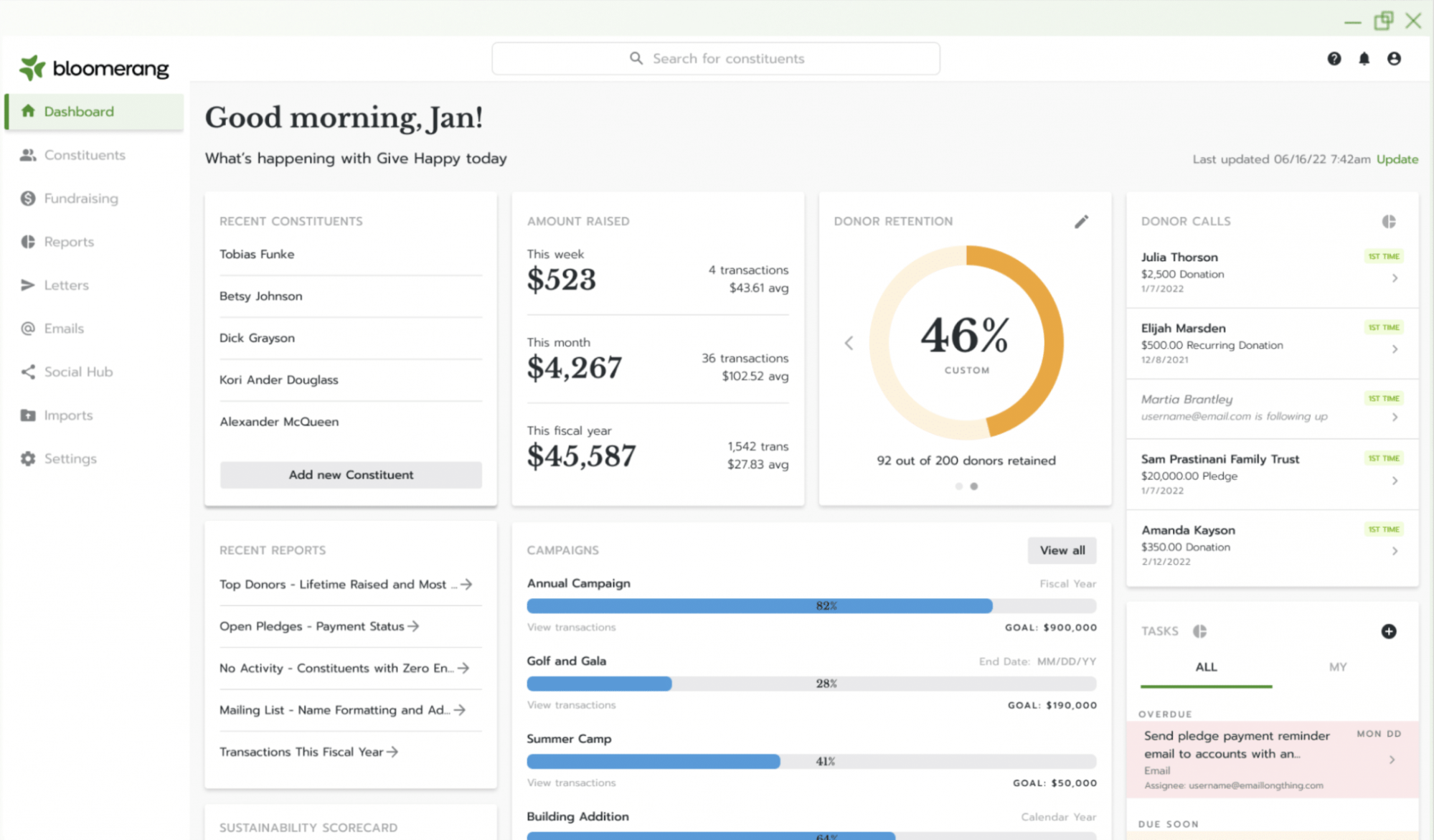
Best for: Small to mid-sized nonprofits focused on improving donor retention rates and understanding giving patterns.
Key Bloomerang Features
- Retention dashboard: Visual analytics showing donor retention rates by segment.
- Engagement timeline: See every interaction with a donor chronologically, from event attendance to email opens.
- Wealth screening integration: Built-in connection to DonorSearch automatically identifies major gift prospects.
Bloomerang Pricing
- Qgiv by Bloomerang: $40/month
- Bloomerang CRM: $125/month
- Bloomerang Volunteer: $119/month
4. Keela
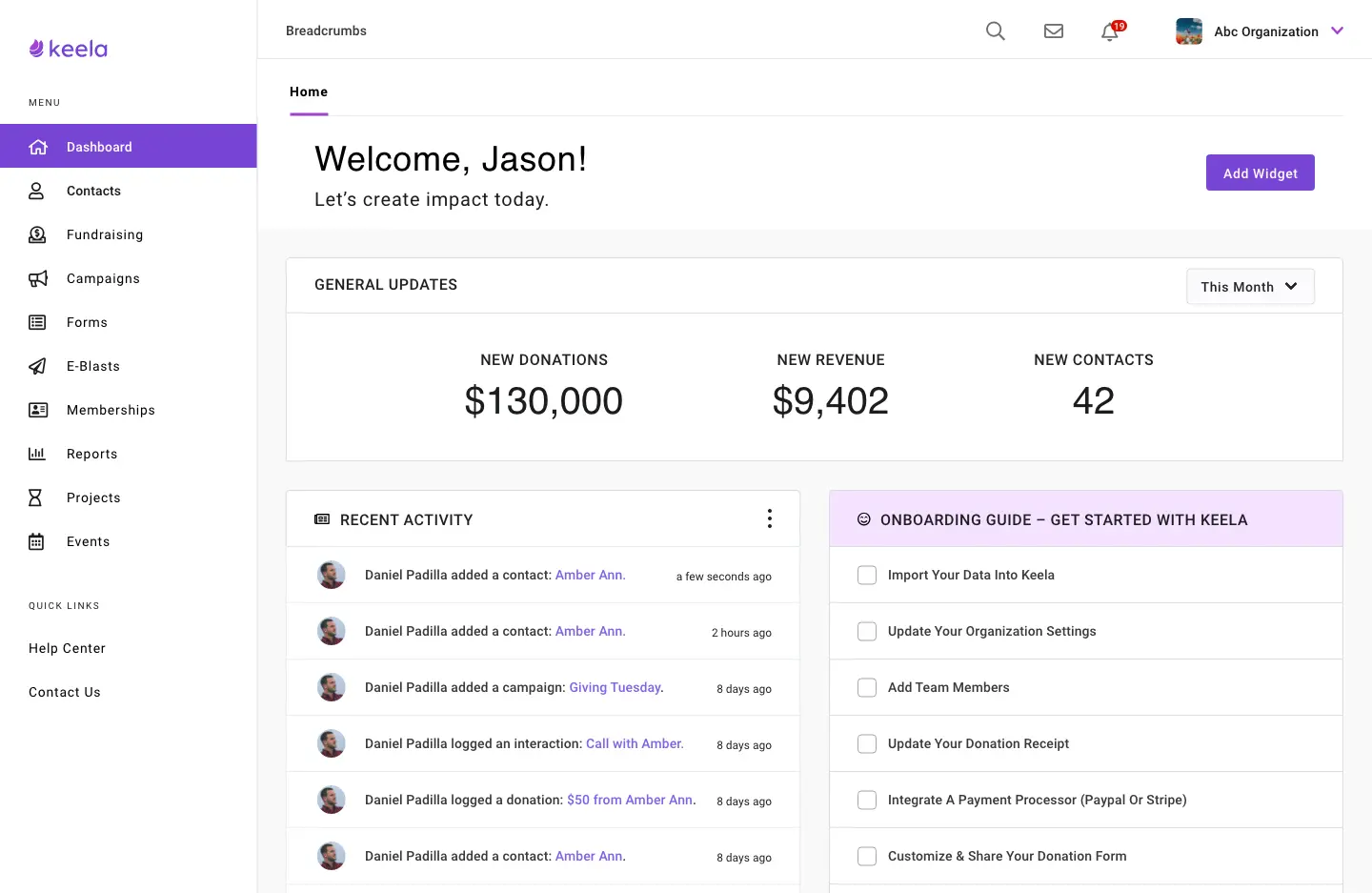
Best for: Established nonprofits running diverse fundraising campaigns from events to peer-to-peer while maintaining clean financial records.
Key DonorPerfect Features
- Smart Ask AI: Predicts optimal donation amounts for each donor based on giving history and capacity.
- Automated donor journeys: Design multi-step communication flows that adapt to donor behavior.
- Built-in email marketing: Create, send, and track email campaigns without leaving the CRM, with automatic list segmentation based on giving patterns.
Keela Pricing
- 1,000 contacts: $134/month
- 1,001 to 2,500 contacts: $209/month
- 5,001 to 7,500 contacts: $329/month
- 7,500 to 10,000 contacts: $379/month
5. Little Green Light
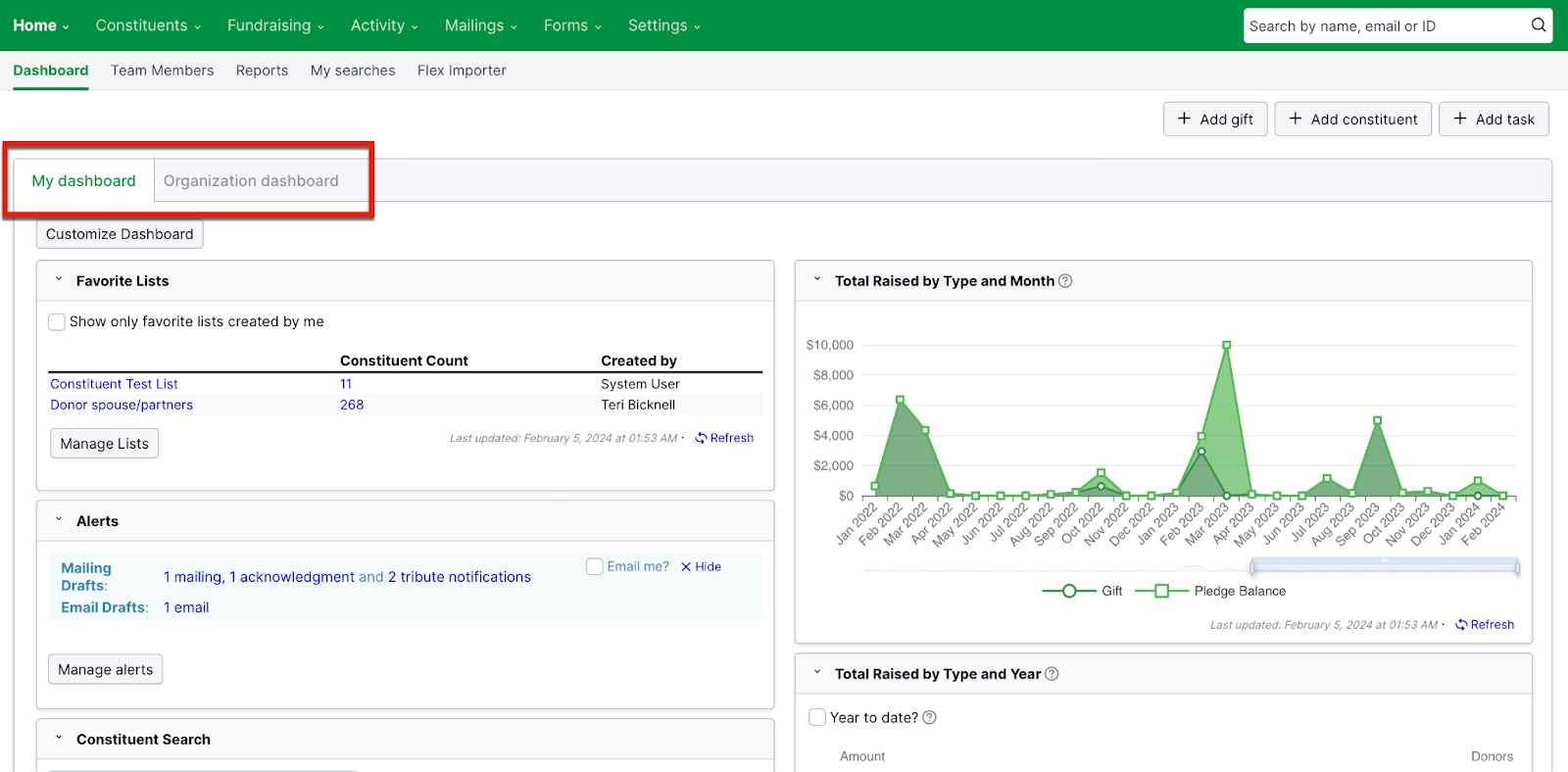
Best for: Grassroots organizations and small nonprofits needing professional donor management without complexity or high costs.
Key Little Green Light Features
- Simplified gift entry: Batch gift entry and automated soft credits to make recording donations from fundraising events quick.
- Constituent workflows: Create custom pipelines for volunteer recruitment, board nominations, or major gift cultivation.
- Email integration via Mailchimp: Sync constituent data with Mailchimp for sophisticated email campaigns while maintaining gift history in LGL.
Little Green Light Pricing
- 2,500 contacts: $45/month
- 5,000 contacts: $60/month
- 10,000 contacts: $75/month
- 20,000 contacts: $90/month
Benefits of CRM Software for Nonprofits
Eliminate Donor Data Silos for Complete Relationship Visibility
Nonprofits often track donor information across disconnected spreadsheets, email platforms, and paper files, making it impossible to see a donor’s full engagement history. However, HubSpot’s unified CRM platform solves this by centralizing every interaction, from the first website visit to a significant gift, event attendance, and volunteer hours, in one searchable database.
HubSpot’s contact timeline feature means any staff member can instantly access a donor's complete history before making a call, writing a grant report, or planning the next ask. Unlike fragmented systems from competing CRMs, HubSpot automatically connects website activity, email engagement, donation history, and event participation into comprehensive donor profiles that update as changes happen.
Automate Repetitive Tasks to Focus on Mission-Critical Work
Development teams waste countless hours on manual tasks like sending donation receipts, updating spreadsheets after events, and creating thank-you letters. HubSpot’s workflow automation eliminates these time-consuming processes by triggering actions based on donor behavior — donation receipts send instantly through <a href="https://www.hubspot.com/products/marketing/email">HubSpot’s email tools</a>, donor records update automatically when someone registers for an event via HubSpot Forms, and personalized thank-you sequences launch based on gift size.
With HubSpot’s Marketing Hub, nonprofits can build complex automation sequences that previously required manual intervention.
Improve Donor Retention Through Data-Driven Insights
Most nonprofits struggle to identify which supporters are at risk of lapsing before it’s too late to re-engage them. HubSpot’s custom dashboards and contact scoring capabilities provide retention analytics that flag at-risk donors automatically based on engagement patterns and giving history.
HubSpot’s reporting tools allow staff to create saved views showing who hasn’t given in 13 months, whose email engagement is declining, or which monthly donors have failed payments. Combined with HubSpot's list segmentation, these insights trigger automated re-engagement campaigns through HubSpot Workflows, enabling proactive outreach that saves relationships before donors fully disengage.
Scale Fundraising Efforts Without Adding Staff
Small nonprofit teams need to manage increasingly complex fundraising campaigns — from peer-to-peer to events to major gifts — without the budget to hire additional staff. HubSpot enables small teams to run sophisticated multi-channel campaigns through its all-in-one platform, where one person can:
- Manage a peer-to-peer campaign for hundreds of fundraisers using HubSpot’s campaign tools
- Send segmented email appeals to thousands through HubSpot’s drag-and-drop email builder
- Track event RSVPs via HubSpot Forms
HubSpot’s templates and cloning features mean successful campaigns can be replicated instantly, while its automation handles follow-ups, reminders, and donor journeys that previously required an entire department. The platform’s free tier supporting up to 1 million contacts means even resource-constrained nonprofits can access enterprise-level capabilities through HubSpot.
Ensure Financial Accuracy and Compliance Across Teams
When development and finance teams use different systems, gift totals rarely match, making board reports unreliable and audit preparation nightmarish. HubSpot’s Operations Hub and native integrations with accounting software like QuickBooks ensure gift data flows seamlessly between fundraising and financial systems, eliminating discrepancies.
HubSpot’s custom reporting builder means that the development campaign totals always match the finance books because both pull from the same source of truth. Additionally, grant reports in HubSpot pull accurate data automatically using filtered views, and year-end tax receipts are generated error-free through HubSpot’s document automation, protecting donor trust and organizational compliance while saving weeks of manual reconciliation during audit season.
5 Important Features for a Nonprofit CRM
- Donor retention analytics and engagement scoring: Track retention rates by segment, identify lapsing donors, and monitor engagement trends over time. HubSpot’s custom dashboards and contact scoring features help nonprofits address the critical challenge of keeping donors engaged year after year. At the same time, its activity timeline shows every touchpoint — from email opens to donation history — to inform personalized outreach strategies.
- Multi-channel fundraising integration: Seamlessly manage donations across websites, peer-to-peer campaigns, events, and text-to-give from one platform. HubSpot’s Forms tool captures donations from any channel. At the same time, its Workflows automatically route gifts to the correct campaign and update donor records in real-time, ensuring every gift from galas, Facebook fundraisers, or direct mail flows into unified contact records without manual entry.
- Automated gift processing and acknowledgment: Instantly process donations, send tax receipts, and trigger personalized thank-you messages based on gift size or campaign. HubSpot’s native Stripe and PayPal integrations and its Marketing Hub automation exemplify how nonprofits can acknowledge donors within minutes, not days, using personalized email sequences that adapt based on donation amount and donor history.
- Grant and program management modules: Track multi-year grants, program outcomes, and beneficiary data to demonstrate impact to funders. Plus, HubSpot’s custom objects and properties allow organizations to build grant tracking systems. At the same time, its reporting tools automate compliance dashboards and connect program activities directly to funding sources — all without leaving the HubSpot ecosystem.
- Financial system integration and reporting: Sync donation data with QuickBooks, generate IRS-compliant reports, and ensure the development and finance teams work from identical numbers. HubSpot’s Operations Hub and native integrations eliminate duplicate entry and reconciliation headaches that plague nonprofits during audit season, while its custom report builder maintains accurate financial records for board reporting.
How to Choose a CRM for Nonprofits (Step-by-Step)
Step 1: Map your workflows.
Firstly, start by documenting your organization’s key processes, such as:
- How donations move from first contact to thank-you letter
- How volunteers get recruited and scheduled
- How events flow from planning to post-event follow-up
Then, include every team member who touches donor data, from development to programs to finance. This exercise reveals where manual handoffs slow you down and where automation could multiply your impact.
Step 2: Identify must-have features.
Secondly, based on your workflow mapping, create a prioritized feature list. Most nonprofits need donor management and gift processing as basics, but your specific needs might include:
- Grant tracking for government-funded programs
- Volunteer management for service organizations
- Event tools for gala-heavy fundraisers
Once you’ve done this, distinguish between “must-haves” for day one and “nice-to-haves” you can add later.
Step 3: Compare ease of use and team fit.
Thirdly, request demos focusing on daily tasks your team performs most often, such as:
- Entering donations
- Pulling reports
- Sending acknowledgments
Pay attention to how many clicks each task requires and whether volunteers could learn the system quickly. However, also consider your team’s technical comfort level.
For example, Salesforce may offer powerful customization, but it requires hands-on training; conversely, Little Green Light provides simplicity for volunteer-run organizations but likely isn’t suited for enterprise-level nonprofits.
Step 4: Check cost at scale.
Next, calculate the total cost of ownership beyond monthly fees. Be sure to factor in the following:
- Number of user licenses needed
- Contact database growth (3 to 5 years is, typically, a good measurement timeline)
- Training and implementation costs
- Integration expenses for connecting existing tools
Remember that switching CRMs is disruptive — choose a platform you can afford as you grow, not just today.
Step 5: Choose a flexible platform — Like HubSpot.
Lastly, select a CRM that grows with your organization’s evolving needs. HubSpot exemplifies this flexibility: Back in 2020, World Wildlife Fund (WWF), a leading non-profit, turned to HubSpot’s CMS to organize its biggest global campaign of the year, Earth Hour.
WWF sought to optimize its content strategy and, through segmenting its user base, increased audience engagement with Earth Hour-specific initiatives. By utilizing HubSpot’s Content Hub and Marketing Hub, World Wildlife Fund could centralize its website data and use that data to inform targeted email and social media strategies, ultimately leading to a 9,493% increase in newsletter signups.
WWF’s success with HubSpot’s tools proves that an investment in HubSpot isn’t just a tech stack investment. It’s an intentional step toward results-driven, personalized marketing that resonates with your supporters and drives long-term impact.
Frequently Asked Questions
What is the best CRM for nonprofits?
The best CRM for nonprofits depends on your organization’s size and needs. HubSpot offers the most potent combination of features and value with its robust free tier, which supports up to 1 million contacts. Its all-in-one platform provides the most flexibility for growing nonprofits.
What features should I look for in a CRM for nonprofits?
Essential nonprofit CRM features include:
- Donor management with giving history tracking
- Automated gift acknowledgments and tax receipts
- Multi-channel fundraising tools (online, events, peer-to-peer)
- Integration with accounting software
- Retention analytics to identify at-risk donors
HubSpot is well-equipped to manage all these areas while providing volunteer management, grant tracking, and built-in email marketing capabilities that many other CRMs charge extra for.
Is HubSpot good for nonprofits?
Yes, HubSpot is excellent for nonprofits, particularly growing organizations.
Its free tier provides comprehensive donor management, email marketing, and basic automation for up to 1 million contacts — unmatched in the industry. Additionally, the platform integrates payment processing, automates donor journeys, and scales affordably as you grow.
BTW: Many nonprofits start free and upgrade only when they need advanced features like workflow automation or custom reporting.
How much does a CRM for nonprofits cost?
Nonprofit CRM costs range from free to $600+ monthly. HubSpot offers the most generous free tier in the industry; its free tier supports unlimited users with up to 1 million contacts.
How long does it take to implement a nonprofit CRM?
Implementation timelines vary by system complexity and data volume. Thanks to its intuitive interface and free onboarding support, HubSpot typically goes live in 1-2 weeks, faster than most competitors. HubSpot’s quick-start programs and extensive knowledge base help nonprofits launch basic functionality within days.
Can multiple team members use a nonprofit CRM simultaneously?
Yes, CRMs are designed for team collaboration. HubSpot offers unlimited users even on its free plan, while most competitors charge per user.
The platform provides granular role permissions — development directors see everything while volunteers might only access event check-in. Unlike spreadsheet-based systems, HubSpot’s real-time updates ensure everyone works from current data with cloud-based access from any device, anywhere.
Meet HubSpot, the Top CRM Choice for Nonprofit Companies
HubSpot stands out as the premier CRM solution for nonprofits by offering enterprise-level capabilities at a price point that works for charitable organizations. Unlike traditional nonprofit software that charges based on donor count or requires expensive implementations, HubSpot provides a robust free tier supporting up to 1 million contacts, making it accessible to organizations of any size.
Key HubSpot Features for Nonprofits
- Free Forever foundation: Start with comprehensive donor management, email marketing, and form builders at no cost, then scale features as your budget allows without migrating platforms.
- Integrated fundraising workflows: Process donations through native Stripe/PayPal integrations while automatically triggering personalized thank-you sequences based on gift amount and donor history.
- 360-degree constituent view: Track every touchpoint from first website visit through significant gift in one timeline, ensuring any staff member can converse with supporters.
Proven Real-World Impact with HubSpot
HubSpot transformed British Red Cross Training’s ability to serve over 100,000 UK businesses with critical first aid and mental health training by replacing their technically complex systems with an integrated, user-friendly platform. Moreover, over two years, the nonprofit achieved a remarkable 66% revenue increase by shifting from costly paid advertising and cold calling to HubSpot’s inbound marketing strategy that automatically generates warm leads.
All-in-all, HubSpot’s true power lies in its flexibility — start free, pay only for what you need, and never outgrow your system. With built-in tools for volunteer management, event coordination, and impact reporting, HubSpot eliminates the need for multiple disconnected tools that drain your budget and staff time.
Ready to see how HubSpot can transform your nonprofit’s donor relationships? Get started with HubSpot’s free nonprofit tools today.


